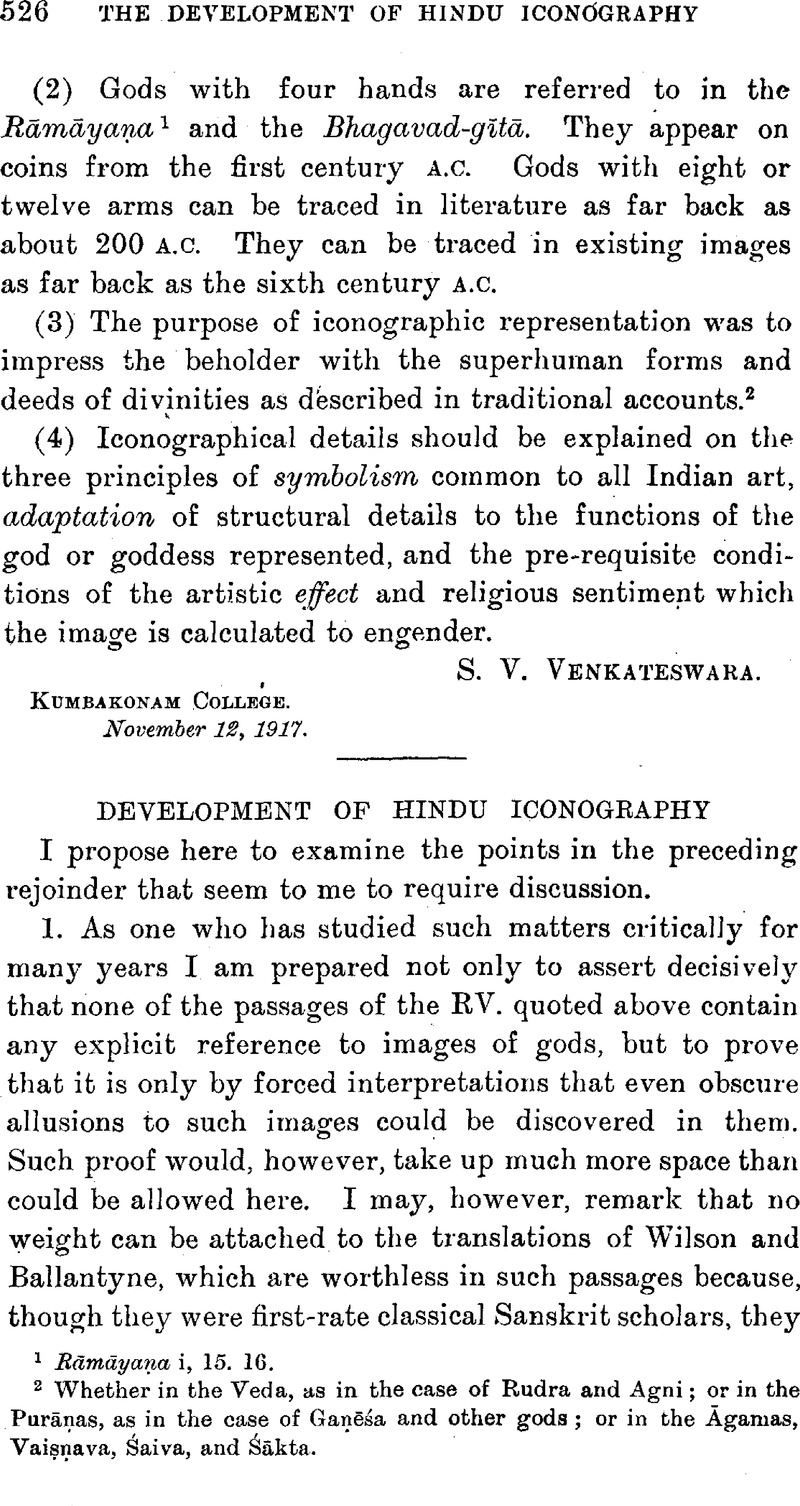No CrossRef data available.
Published online by Cambridge University Press: 15 March 2011

page 526 note 1 Rāmāyaṇa i, 15. 16.Google Scholar
page 526 note 2 Whether in the Veda, as in the case of Rudra and Agni; or in the Purāṇas, as in the case of Gaṇēśa and other gods; or in the Āgamas, Vaiṣṇava, Śaiva, and Śākta.
page 527 note 1 See my History of Sanskrit Literature, pp. 282 and 303Google Scholar, to which I could add a good deal more regarding the variations of the text of the epics; but this is not the place to do so. The text of even the Bhagavad-gītā is not fully guaranteed till the ninth century a.c. by the commentary of Śaṅkara.
page 528 note 1 Cf. Keith, , JRAS. 1916, pp. 130–7Google Scholar; Jolly, , ZDMG. lxviii, 355–9.Google Scholar
page 528 note 2 Sanskrit Literature, pp. 299–302.Google Scholar
page 528 note 3 Cf. Sastri, H. Krishna, South Indian Images of Gods and Goddesses, p. 161Google Scholar, where the Kāśyapa-śilpa is quoted as describing the Chaṇḍeśa form of Śiva as having sixteen arms in the Kṛta, eight in the Tretā, four in the Dvāpara age, while he has only two in the Kali, (p. 163).Google Scholar
page 529 note 1 Cf. op. cit., p. 165.
page 529 note 2 Thus the Purāṇas state that Dharma had four legs for its support in the Kṛta age, three in the Tretā, two in the Dvāpara, and has only one in the Kali age. Again, they say that the Kṛta age lasts 1,440,000 human years, the Tretā 1,080,000 years, the Dvāpara 720,000, and the Kali 360,000.
page 529 note 3 The Śilpasāra does not even mention the vajra among his weapons or symbols, see Krishna Sastri, p. 241; but it is referred to in Hēmādri, ibid.
page 530 note 1 JRAS. 1917, p. 588.Google Scholar
page 530 note 2 Even here they are not entirely absent; see Sastri, Krishna, op. cit., p. 238.Google Scholar
page 530 note 3 These abnormal features are actually represented in a South Indian image; see Sastri, Krishna, op. cit., p. 244.Google Scholar
page 530 note 4 See Vedic Mythology, p. 93.Google Scholar
page 530 note 5 Though he is often called dvi-janman, “having two births,” with reference to his origin in heaven and earth.
page 530 note 6 JRAS. 1917, p. 598, 5.Google Scholar
page 531 note 1 Malabar Quarterly, 03, 1904.Google Scholar
page 531 note 2 JRAS. 1917, p. 597.Google Scholar
page 531 note 3 Ibid.
page 531 note 4 See Sastri, Krishna, op. cit., p. 187.Google Scholar
page 532 note 1 Op. cit., pp. 76 (footnote 1) and 89. Some Āgamas refer to 108 dancing forms of Śiva alone; see op. cit., p. 88.
page 532 note 2 Op. cit., p. 173.
page 533 note 1 Besides Gangoly, 's South Indian BronzesGoogle Scholar and Rao, Gopinātha's ElementsGoogle Scholar, I may here further refer to Sastri, H. Krishna's South Indian Gods and GoddessesGoogle Scholar, which is full of illustrations of this point, e.g., pp. 16, 18, 19, 26, 27, 54, 80, 87, 98, 109, 117, 119, 134, 139, 146, 150, 157, 164, 179, 200, 242.
page 533 note 2 Skanda Purāṇa, quoted by Sastri, Krishna, p. 77; cf. p. 151.Google Scholar
page 534 note 1 Op. cit., p. 173.
page 533 note 2 The Buddhist artist, his predecessor or contemporary, represented the gods in purely human shape, as exemplified by Laksml at Sanehi (second century b.c.), and Indrain the Gaudhāra sculptures of the northwest (first century a.c.).
page 533 note 3 I do not understand what is meant by saying that “the art of a nation … is due to an overflow … of thoughts too definite to be put into words”.